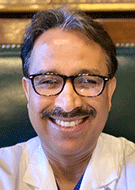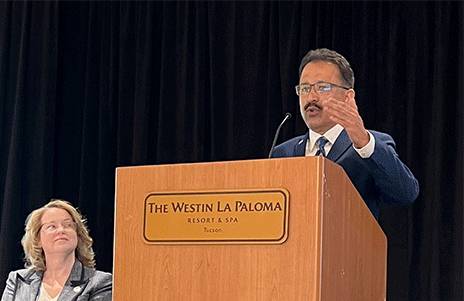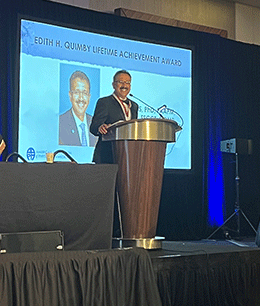RSNA Member Spotlight: M. Mahesh, PhD, MS
Learn more about a fellow RSNA member

M. Mahesh, PhD, MS, is a professor in the Department of Radiology and Radiological Science and the Division of Cardiology at Johns Hopkins University School of Medicine in Baltimore. Dr. Mahesh, a medical physicist, also holds a joint appointment with the Johns Hopkins Bloomberg School of Medicine Department of Environmental Health. He is president-elect of the American Association of Physicists in Medicine (AAPM) and will be President of AAPM in 2025.
Dr. Mahesh earned bachelor’s degrees in math, electronics and physics and a master’s degree in solid-state physics from the University of Mysore in India. He completed a master’s in physics at Marquette University in Milwaukee and obtained his doctorate in medical physics from the Medical College of Wisconsin (MCW) in Milwaukee. Dr. Mahesh is a fellow in several societies including the AAPM, the American College of Radiology (ACR), the American College of Medical Physics (ACMP), the Society of Cardiovascular Computed Tomography (SCCT) and the International Organization for Medical Physics (IOMP).
An engaged medical physics and imaging researcher with special interest in the areas of multiple-row detector CT, interventional fluoroscopy and digital mammography, Dr. Mahesh has offered his editorial expertise to several radiology publications including Academic Radiology, the Journal of the American College of Radiology (JACR), Radiology and RadioGraphics. Dr. Mahesh is the associate editor and medical physics column editor of JACR. He has made several appearances as a faculty member and session moderator at the RSNA annual meeting and is a generous supporter of the RSNA R&E Foundation.

What has been your best career accomplishment?
There are several - one I like to highlight is my opportunity to work "across the aisle" not only in the medical physics field, but also in the fields of radiology, cardiology and radiation oncology, in general. Working along with these physicians has been a good accomplishment reflected in my fellowship across five different societies. I work with the cardiologists; I work with the radiologists, and I served as a member of the board of the ACR and the SCCT.
Because of my mentors, I got involved with the professional societies and the American Board of Radiology early on, and I have been coming to RSNA ever since. Several years ago, RSNA was trying to help prepare radiology residents for their physics boards, and RSNA and the AAPM came together to develop physics modules. I was a charter member of the committee that wrote the first modules (CT Dose). Drs. George Bisset and Bill Hendee were the leaders of this effort, and when George became RSNA president, he invited me to be the second vice president. I consider this to be one of the highlights of my career.
In addition to the AAPM Symposium, we also hold physics tutorials on Saturday at the RSNA meeting, and I chaired that committee for several years. During the five or six years while I was chair, we created AAPM/RSNA physics tutorials that were later published in RadioGraphics. It allowed me to work closely with the then editor of RadioGraphics, Dr. William (Bill) Olmsted, who invited me to serve as physics panel chair on the editorial board. This type of crossover relationship enhances the collaborative work between medical physicists and radiologists. Because of my work on RadioGraphics, and my expertise in medical physics, I was invited to serve as the associate editor for physics in Radiology.
One other highlight of my professional accomplishments is the Edith Quimby award I received in 2023 from AAPM. As noted on the AAPM website the award, “recognizes members whose careers have been notable based on their outstanding achievements in the field of medical physics.”
What has been the biggest challenge you have faced in building your career?
An ongoing challenge has been that as diagnostic imaging physicists, we are still not required and often not recognized and supported by radiologists and others in the department for the full value we can bring. The decision to hire medical physicists depends on the administration and the leadership and depends on whether they recognize our value.
I, along with my colleagues, are pushing for better recognition and understanding for the value we bring to image quality and patient safety.
Early in my career, a big challenge came in finding the best way to build my research portfolio, balancing my clinical and research work. I'm lucky enough to have created some pathways, but it was a challenge. Balancing my work and home life was also a challenge, but fortunately my wife and kids have been very supportive of my activities not only at work but also with the professional societies.

What RSNA resources do you use in your professional development and daily practice?
I use most of the resources made available by RSNA. Recently, as a medical physicist who is not an AI researcher, I wanted to gain more understanding about AI because I wanted to see what I could do for the AAPM. So, I took the RSNA AI Certificate Program, and I learned a lot. This year, we at AAPM are doing a specialty meeting—an AI boot camp for clinical medical physicists. The knowledge I gained and the way RSNA taught it was invaluable, and we can use that to customize our meeting to what medical physicists need to learn about AI in clinical practice.
No matter what I give to RSNA, I get 10 times more back. I am a constant reader of the journals. I've been lucky because many of my articles in Radiology and RadioGraphics are frequently cited and downloaded, reaching a wide audience. It's a good feeling because it means that what I am contributing to the field is valuable, and others are recognizing and reading it. I'm also active on social media and like to share many of the articles I read in Radiology and other journals and draw readers to the RSNA website.
The way RSNA has grown and is growing, it is unbelievable how valuable it is to the field of medical physics. RSNA resources are very strong and well respected around the world.
When you’re not working, how do you spend your free time?
I like reading things outside of physics—novels and poetry. And I like walking. So, these days, I combine two activities like reading while walking.
I was reading recently about what will drive us toward happiness. The author nicely distilled this into three points: 1. Take a hike. 2. Read a book. 3. Call a friend—and I do these things! They really connect people and help with the problems we are hearing about today, like tension, mental health issues, burnout and loneliness.
The tagline in my email is, "Be Curious," and that's what I tell all my students and mentees. Beyond your work, just as a human, be curious. Sometimes we might spend an hour in a doctor's waiting room avoiding eye contact with anybody else; we seem to be closed off and then we say we feel isolated. Start a chat! Connect with people outside of your usual group. It will make your day better. I do it, and I benefit from many good interactions.
For More Information
Connect with Dr. Mahesh on X @mmahesh1.
Keep up to date with RSNA member achievements, moves and news by visiting RSNA.org/News/Announcements/Member-Updates.